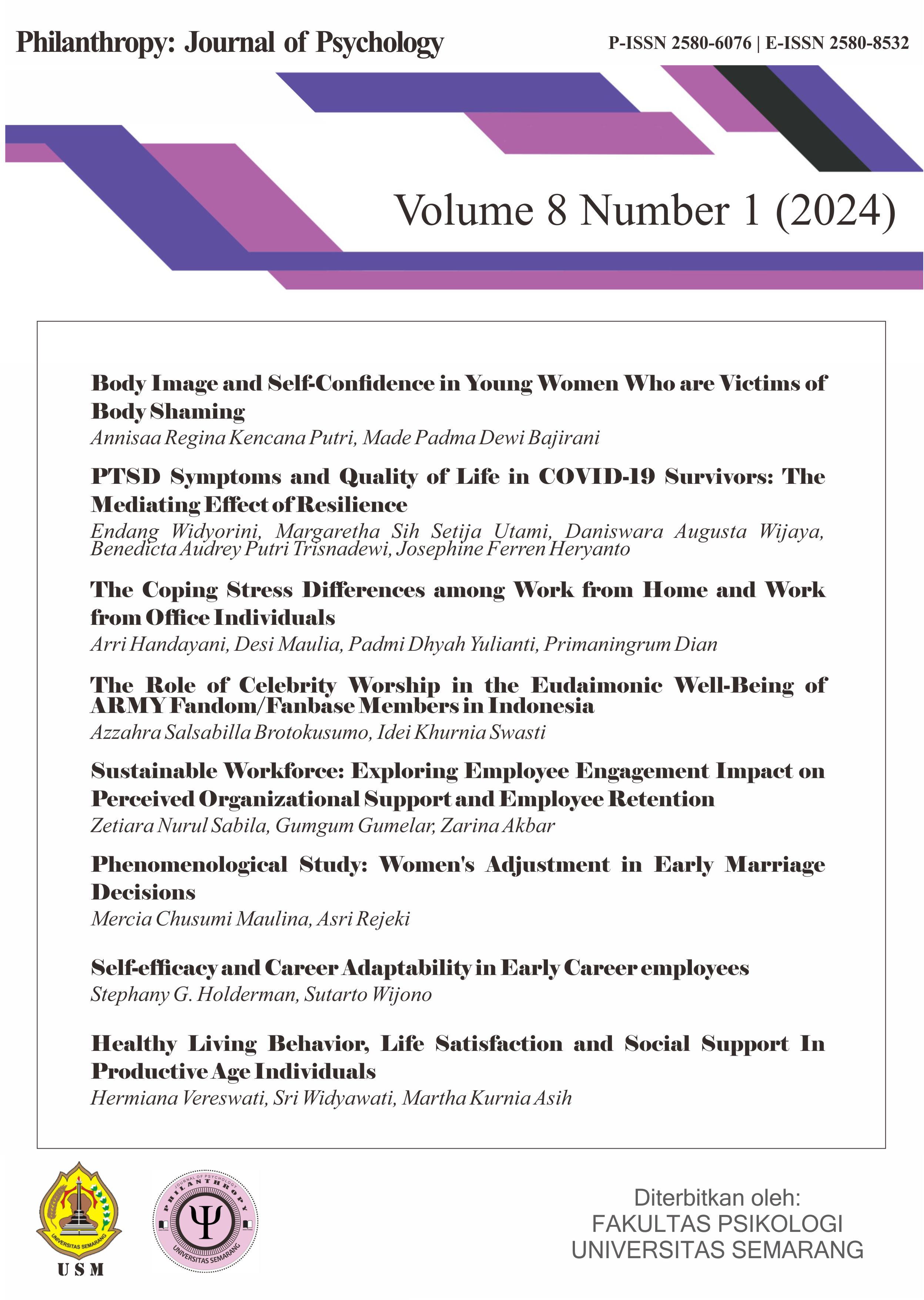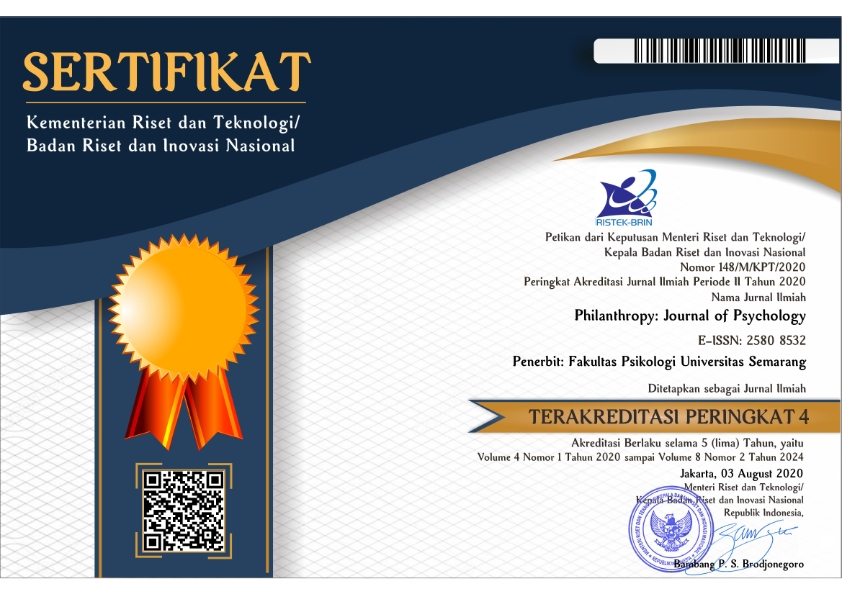The Role of Celebrity Worship in the Eudaimonic Well-Being of ARMY Fandom/Fanbase Members in Indonesia
DOI:
https://doi.org/10.26623/philanthropy.v8i1.7865Abstract
Abstract. Celebrity worship is a parasocial relationship with one or more celebrities driven by identity absorption and addiction to everything related to the celebrity. However, previous studies state that celebrity worship positively impacts the worshipers if they join the fandom. In a quantitative study design, the current study aims to determine the role of celebrity worship on the eudaimonic well-being of members of the BTS-ARMY fandom in Indonesia. There were 207 participants aged 18-25 who had joined the BTS-ARMY fandom for at least one year before the study. Data was gained using online questionnaires. The result of simple linear regression shows that celebrity worship has a positive role in eudaimonic well-being (R2=0.020; p < 0.05). By linking these two variables of the BTS-ARMY members in Indonesia, the finding contributes to understanding eudaimonic well-being in celebrity worshiping as a nonpathological activity. Further research investigation is required to support this result, for example, by focusing on the group dynamics of the fandom community.
Keywords: BTS; Celebrity Worship; Eudaimonic Well-being; fandom ARMY
References
Anderson, C. (2019). Women in Online Science Fiction Fandoms: Perceived impact on psychological well-being [Doctoral dissertation]. Capella University.
Arnett, J. J. (2006). Emerging Adulthood: Understanding the New Way of Coming of Age. In Emerging adults in America: Coming of age in the 21st century. (pp. 3–19). American Psychological Association. https://doi.org/10.1037/11381-001
Azwar, S. (2017). Metode penelitian. Pustaka Belajar.
Brooks, S. K. (2021). FANatics: Systematic literature review of factors associated with celebrity worship, and suggested directions for future research. Current Psychology, 40(2), 864–886. https://doi.org/10.1007/s12144-018-9978-4
Brown, W. J. (2015). Examining four processes of audience involvement with media personae: Transportation, parasocial interaction, identification, and worship. Communication Theory, 25(3), 259–283. https://doi.org/10.1111/comt.12053
Cahyani, D., & Purnamasari, Y. (2018). Celebrity Worship on Early Adult K-Pop Fangirling. Advances in Social Science, Education and Humanities Research (ASSEHR), 304, 167–170.
Cheung, C.-K., & Yue, X. D. (2011). Pentangular Dimensions of Chinese Adolescents’ Idol Worship. International Journal of Adolescence and Youth, 16(3), 225–244. https://doi.org/10.1080/02673843.2011.9748058
Chia, S. C., & Poo, Y. L. (2009). Media, Celebrities, and Fans: An Examination of Adolescents’ Media Usage and Involvement with Entertainment Celebrities. Journalism & Mass Communication Quarterly, 86(1), 23–44. https://doi.org/10.1177/107769900908600103
Diener, E. (2000). Subjective well-being: The science of happiness and a proposal for a national index. American Psychologist, 55(1), 34–43. https://doi.org/10.1037/0003-066X.55.1.34
Diener, E., Suh, E. M., Lucas, R. E., & Smith, H. L. (1999). Subjective well-being: Three decades of progress. Psychological Bulletin, 125(2), 276–302. https://doi.org/10.1037/0033-2909.125.2.276
Duffet, M. (2013). Understanding Fandom: An Introduction to the Study of Media Fan Culture. Bloomsbury Publishing.
Etikan, I. (2016). Comparison of Convenience Sampling and Purposive Sampling. American Journal of Theoretical and Applied Statistics, 5(1), 1. https://doi.org/10.11648/j.ajtas.20160501.11
Forsyth, D. R. (2018). Group Dynamic (7th ed.). Cengage Learning.
Ghozali, I. (2016). Aplikasi analisis multivariate dengan program IBM SPSS 23. BPFE Universitas Diponegoro.
Hackley, C., & Hackley, R. A. (2016). The iconicity of celebrity and the spiritual impulse. Consumption Markets & Culture, 19(3), 269–274. https://doi.org/10.1080/10253866.2015.1094264
Hart, R. (2020). Positive Psychology. Routledge.
Herman, T. (2020). 10 years on, Twitter is shaping the spread of K-pop. Forbes.
Huta, V. (2015). An overview of hedonic and eudaimonic well-being concepts (L. Reinecke & O.M.B). Routledge.
Jung, S. (2011). K-pop, Indonesian fandom, and social media. Transformative Works and Cultures, 8. https://doi.org/10.3983/twc.2011.0289
Kang, J., Kim, J., Yang, M., Park, E., Ko, M., Lee, M., & Han, J. (2022). Behind the scenes of K-pop fandom: unveiling K-pop fandom collaboration network. Quality & Quantity, 56(3), 1481–1502. https://doi.org/10.1007/s11135-021-01189-5
Kaufman, G. (2021, August 3). BTS renew commitment to ‘Love Myself’ anti-violence campaign with UNICEF. Billboard. Diakses melalui https://www.billboard.com/music/music-news/bts-renew-commitment-love-myself-anti-violence-campaign-unicef-9536408/
Kelley, C. (2019, January 11). BTS lead the growth of hallyu to nearly 90 milion fans worldwide in 2018. Forbes. Diakses melalui https://www.forbes.com/sites/caitlinkelley/2019/01/11/bts-lead-growth-of-hallyu-90-million-fans-2018/
Kim, M.-S., & Kim, H.-M. (2017). The effect of online fan community attributes on the loyalty and cooperation of fan community members: The moderating role of connect hours. Computers in Human Behavior, 68, 232–243. https://doi.org/10.1016/j.chb.2016.11.031
Kim, P., & Hutt, E. (2021). K-pop as a Social Movement: Case Study of BTS and Their Fandom ARMY. Journal of Student Research, 10(3). https://doi.org/10.47611/jsrhs.v10i3.1772
Kim, S., Hwang, S., & Kim, J. (2021). Factors influencing K-pop artists’ success on V live online video platform. Telecommunications Policy, 45(3), 102090. https://doi.org/10.1016/j.telpol.2020.102090
King, B. (2013). Fame attack: the inflation of celebrity and its consequences, by Chris Rojek. Celebrity Studies, 4(2), 262–264. https://doi.org/10.1080/19392397.2013.791060
King-O’Riain, R. C. (2021). “They were having so much fun, so genuinely . . .”: K-pop fan online affect and corroborated authenticity. New Media & Society, 23(9), 2820–2838. https://doi.org/10.1177/1461444820941194
Laffan, D. A. (2020). Positive Psychosocial Outcomes and Fanship in K-Pop Fans: A Social Identity Theory Perspective. Psychological Reports, 124(5), 2272–2285. https://doi.org/10.1177/0033294120961524
Lim, S., & Giouvris, E. (2020). Tourist arrivals in Korea: Hallyu as a pull factor. Current Issues in Tourism, 23(1), 99–130. https://doi.org/10.1080/13683500.2017.1372391
Mach, M., Dolan, S., & Tzafrir, S. (2010). The differential effect of team members’ trust on team performance: The mediation role of team cohesion. Journal of Occupational and Organizational Psychology, 83(3), 771–794. https://doi.org/10.1348/096317909X473903
Maltby, J., Day, L., McCutcheon, L. E., Gillett, R., Houran, J., & Ashe, D. D. (2004). Personality and coping: A context for examining celebrity worship and mental health. British Journal of Psychology, 95(4), 411–428. https://doi.org/10.1348/0007126042369794
Maltby, J., Houran, J., Lange, R., Ashe, D., & McCutcheon, L. E. (2002). Thou shalt worship no other gods — unless they are celebrities: the relationship between celebrity worship and religious orientation. Personality and Individual Differences, 32(7), 1157–1172. https://doi.org/10.1016/S0191-8869(01)00059-9
Maltby, J., McCutcheon, L. E., Ashe, D. D., & Houran, J. (2001). The self-reported psychological wellbeing of celebrity worshippers. North American Journal of Psychology, 3(3), 441–452.
McCutcheon, L. E., Aruguete, M., McCarley, N. G., & Jenkins, W. J. (2016). Further validation of an indirect measure of celebrity stalking. Journal of Studies in Social Sciences, 14(1), 75–91.
McCutcheon, L. E., Lange, R., & Houran, J. (2002). Conceptualization and measurement of celebrity worship. British Journal of Psychology, 93(1), 67–87. https://doi.org/10.1348/000712602162454
McCutcheon, L. E., Scott Jr, V. B., Aruguete, M. S., & Parker, J. (2006). Exploring the link between attachment and the inclination to obsess about or stalk celebrities. North American Journal of Psychology, 8(2), 289–300.
McMahan, E. A., & Estes, D. (2011). Hedonic Versus Eudaimonic Conceptions of Well-being: Evidence of Differential Associations with Self-reported Well-being. Social Indicators Research, 103(1), 93–108. https://doi.org/10.1007/s11205-010-9698-0
Messaris, P. (2016). The global impact of South Korean popular culture: Hallyu unbound. Asian Journal of Communication, 26(2), 194–197. https://doi.org/10.1080/01292986.2015.1121611
O’Donovan, R. (2016). ‘To Boldly Go Where No Psychologist Has Gone Before”: Effects of Participation in Fandom Activities on Parasocial Relationships. Relationships. Journal of Applied Psychology and Social Science, 2(1), 41–61.
Rahim, A. A. (2019). Online Fandom: Social Identity and Social Hierarchy of Hallyu Fans. Journal for Undergraduate Ethnography, 9(1), 65–81.
Redmond, S. (2016). The passion plays of celebrity culture. European Journal of Cultural Studies, 19(3), 234–249. https://doi.org/10.1177/1367549415609326
Reyes, M. E., Santiago, A. G., Domingo, A. J., Lichingyao, E. N., Onglengeo, M. N., & McCutcheon, L. E. (2016). Fandom: Exploring the relationship between mental health and celebrity worship among filipinos. North American Journal of Psychology, 18(2), 307–316.
Reysen, S., Plante, C., & Chadborn, D. (2017). Better together: Social connections mediate the relationship between fandom and well-being. AASCIT Journal of Health, 4(6), 68–73.
Ryan, R. M., & Deci, E. L. (2001). On Happiness and Human Potentials: A Review of Research on Hedonic and Eudaimonic Well-Being. Annual Review of Psychology, 52(1), 141–166.
https://doi.org/10.1146/annurev.psych.52.1.141
Santoso, S. (2015). Statistik untuk psikologi. Universitas Sanata Dharma.
Scott-Maxwell, A. (2020). K-pop flows and Indonesian student pop scenes: situating live Asian pop music in an ‘Asian’ Australia. Media International Australia, 175(1), 20–35. https://doi.org/10.1177/1329878X20906550
Seo, J. H., & Kim, B. (2020). The “Hallyu” phenomenon: Utilizing tourism destination as product placement in K-POP culture. Tourism Economics, 26(4), 719–728. https://doi.org/10.1177/1354816619837111
Sharon, T. (2016). Constructing Adulthood. Emerging Adulthood, 4(3), 161–167. https://doi.org/10.1177/2167696815579826
UNICEF. (2018, September 24). We have learned to love ourselves, so now I urge you to ‘speak yourself’.” [press release], diakses melalui https://www.unicef.org/press-releases/we-have-learned-love-ourselves-so-now-i-urge-you-speak-yourself
UNICEF. (2019, July 29). BTS supports #ENDviolence. UNICEF. [press release], diakses melalui https://www.unicef.org/press-releases/bts-and-unicef-call-young-people-spread-kindness-international-day-friendship
Waterman, A. S. (2008). Reconsidering happiness: a eudaimonist’s perspective. The Journal of Positive Psychology, 3(4), 234–252. https://doi.org/10.1080/17439760802303002
Waterman, A. S., Schwartz, S. J., Zamboanga, B. L., Ravert, R. D., Williams, M. K., Bede Agocha, V., Yeong Kim, S., & Brent Donnellan, M. (2010). The Questionnaire for Eudaimonic Well-Being: Psychometric properties, demographic comparisons, and evidence of validity. The Journal of Positive Psychology, 5(1), 41–61. https://doi.org/10.1080/17439760903435208
Wickman, G. (2018). Love Yourself: The message behind BTS’s record breaking album series. Medium. Diakses melalui https://medium.com/bangtan-journal/love-yourself-the-message-behind-btss-record-breaking-album-series-229119e81902
Widarjono, A. (2010). Analisis statistika multivariat terapan. Unit penerbit dan percetakan.
Widjaja, A. K., & Ali, M. M. (2015). Gambaran Celebrity Worship pada Dewasa Awal di Jakarta. Humaniora, 6(1), 21. https://doi.org/10.21512/humaniora.v6i1.3294
Yoon, K. (2019). Transnational fandom in the making: K-pop fans in Vancouver. International Communication Gazette, 81(2), 176–192. https://doi.org/10.1177/1748048518802964
Zsila, Á., McCutcheon, L. E., & Demetrovics, Z. (2018). The association of celebrity worship with problematic Internet use, maladaptive daydreaming, and desire for fame. Journal of Behavioral Addictions, 7(3), 654–664. https://doi.org/10.1556/2006.7.2018.76
Zsila, Á., Urbán, R., McCutcheon, L. E., & Demetrovics, Z. (2019). A path analytic review of the association between psychiatric symptoms and celebrity worship: The mediating role of maladaptive daydreaming and desire for fame. Personality and Individual Differences, 151, 109511. https://doi.org/10.1016/j.paid.2019.109511
Zuo, S., Wang, S., Wang, F., & Shi, X. (2017). The Behavioural Paths to Wellbeing: An Exploratory Study to Distinguish Between Hedonic and Eudaimonic Wellbeing from an Activity Perspective. Journal of Pacific Rim Psychology, 11, e2. https://doi.org/10.1017/prp.2017.1
Downloads
Additional Files
Published
Issue
Section
License
The author who will publish the manuscript at Philanthropy: Journal of Psychology, agree to the following terms:
- Authors retain copyright and grant the journal right of first publication with the work simultaneously licensed under a Creative Commons Attribution 4.0 International License (CC BY 4.0), that allows others to share the work with an acknowledgment of the work's authorship and initial publication in this journal.
- Authors are able to enter into separate, additional contractual arrangements for the non-exclusive distribution of the journal's published version of the work (e.g., post it to an institutional repository or publish it in a book), with an acknowledgment of its initial publication in this journal.
- Authors are permitted and encouraged to post their work online (e.g., in institutional repositories or on their website) prior to and during the submission process, as it can lead to productive exchanges, as well as earlier and greater citation of published work (See The Effect of Open Access).




